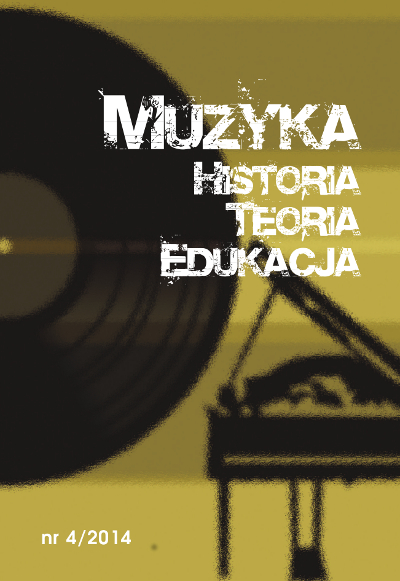Zagadnienia formalno-warsztatowe w kameralnych utworach klarnetowych Witolda Lutosławskiego
DOI:
https://doi.org/10.34767/MHTE.2014.04.05Abstrakt
In my article I focused on formal and technical issues of Witold Lutosławski’s works. His pieces for clarinet constitute a satisfying for researchers fragment of composer’s early works. They allow to analyse Lutosławski’s sound language. Conclusions derived from this analysis will bring us closer to understanding the arcanas of composer’s technique. I will analyse two chamber pieces for clarinet: Dance Preludes and Trio for oboe, clarinet and bassoon.
The formal-verbal plan of the trio originates from traditional models. In this sense the trio ranks among the neoclassical course of the post-war works of Polish composers. It can be seen particularly clearly with reference to the form of work and the tempo (agitato) relation between the parts – three parts are kept in the following tempo: 1st part – Allegro moderato, 2nd – Poco Adagi and 3rd – Allegro giocoso, Rondo. the individual touch of this work is the use of polymeter, which clearly introduces additional aspect dymanizing the course of piece. The structural precision and carefully refined details are among features which according to me are apparent in works of the composer. this phenomenon emerges in wide material references, symmetries between individual particles and the way of treating the instrumental parts.
In Dance Preludes Lutosławski uses folk material in solo part of clarinet whereas the accompanying music is shaped entirely independently with modern means. The cycle of five miniatures is based on changing of the mood – even Preludes are full of life and striking whereas odd Preludes are nostalgic and calm. Dance Preludes are one of the most popular works of the composer and at the same time the last of his work which show the influence of folk music.
Bibliografia
Gwizdalanka Danuta, Meyer Krzysztof, Lutosławski. Droga do dojrzałości, PWM SA, Kraków 2003.
Gwizdalanka Danuta, Meyer Krzysztof, Lutosławski. Droga do mistrzostwa, PWM SA, Kraków 2004.
Lutosławski Witold, Materiały sesji naukowej, Akademia Muzyczna w Krakowie, Kraków 1985, s. 182-183.
Tadeusz Andrzej Zieliński, Droga twórcza Witolda Lutosławskiego, „Ruch Muzyczny” 1968, nr 20.
Podhajski Marek (red.), Kompozytorzy polscy 1918-2000, t. I: Eseje, Akademia Muzyczna w Warszawie, Akademia Muzyczna w Gdańsku, Gdańsk-Warszawa 2005.
Podhajski Marek (red.), Kompozytorzy polscy 1918-2000, t. II: Biogramy, Akademia Muzyczna w Warszawie, Akademia Muzyczna w Gdańsku, Gdańsk-Warszawa 2005.
Kaczyński Tadeusz, Lutosławski. Życia i muzyka, Sutkowski Edition, Warszawa 1994.
Rae Charles Bodman, Muzyka Lutosławskiego, tłum. Stanisław Krupowicz, PWN, Warszawa 1996.

